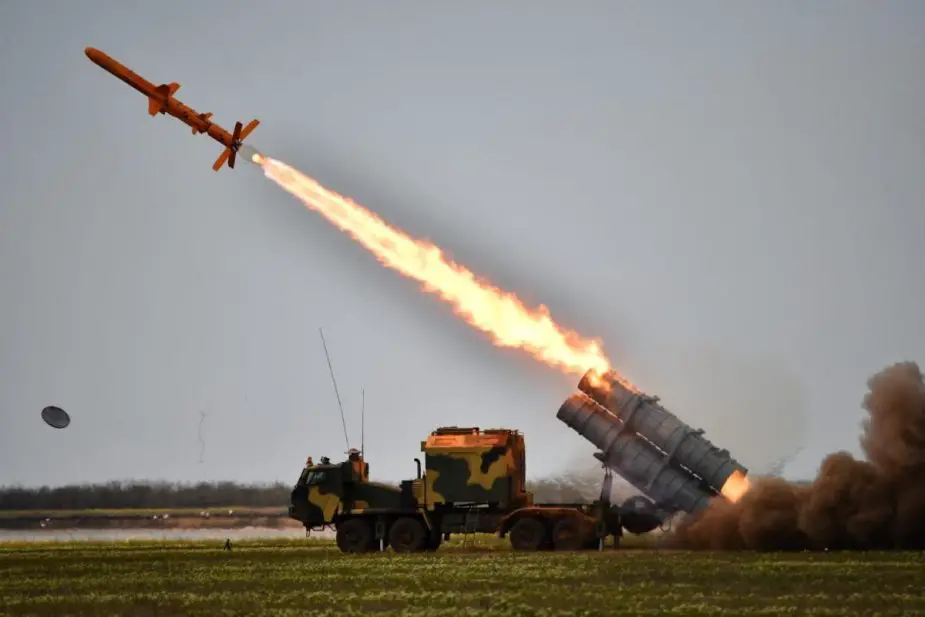The media have been paying much attention to the new Ukrainian antiship Neptune missile of late. Some observers in Kiev claimed it can completely neutralize the Russian fleet in the Black Sea. It is impossible to ignore the claim, TASS military observer Dmitry Litovkin writes.
Follow Navy Recognition on Google News at this link
 The “Neptune” land-based cruise missile system (Picture source: Ukraine Army General Staff)
The “Neptune” land-based cruise missile system (Picture source: Ukraine Army General Staff)
Little is known about Neptune. However, it is clear that it resembles Russian Kh-35 antiship missile. In Soviet time, Luch Design Bureau in Kiev dealt with the missile. The engine had to be produced by Motor Sich and the final assembly done by Kharkov Aircraft Plant. However, the Soviet collapse killed the project. Ukraine inherited all the design documentation and did not lose or sell it in 1990s.
Neptune is not something new. Compared to the Russian Kh-35 (not with the latest Kh-35U), it is truly dangerous. Ukrainian Navy Commander Rear Admiral Alexey Neizhpapa said Ukraine plans to deploy three Neptune battalions on the Black Sea coast. Tactical Missiles Corporation CEO Boris Obnosov said the new Russian Kh-35U missile “considerably differs from the previous one.” It has another engine and a bigger fuel reserve. The range increased to 260 km as a result. Experts believe the new missiles can operate in a group. The Ukrainian missile is incapable of it.
Former chair of the Ukrainian Security and Defense Council Alexander Turchinov claimed Neptune cruise missiles can ruin the Crimean bridge across Kerch Strait “in several minutes.” They will also destroy Russian warships of any class in the ports of the Black and Azov Seas. Naturally, there is such a possibility. However, Turchinov and other Ukrainian experts ignore the fact that they will have to fight against a modern operational and strategic formation of the Russian Navy in Crimea. In Soviet time, it was in charge of the Black and Mediterranean Seas and even the Indian Ocean. The current ambitions are modest, but still large-scale.
Crimea and its main Navy base in Sevastopol comprise the strategic center of the Black Sea theater of warfare. Russia controls all the developments in the region from there. There are the Moskva missile cruiser of project 1164 with antiship Basalt P-500 missiles, blue-water frigates of project 11356 with Kalibr cruise missiles, and several Buyan-M-class corvettes of project 21631 with cruise missiles. There are also six diesel-electric submarines of project 636.3 armed with Kalibr missiles. In 2021, the Black Sea fleet has to receive Karakurt-class corvettes of project 22800.
The naval force is protected from the air by Su-24M frontline bombers, Su-24MR reconnaissance aircraft, and Su-30SM multirole fighter jets. S-400 and Pantsir air defense systems have gone on combat duty. The coastline is defended by Bal batteries with antiship Kh-35 missiles and Bastion with Onyx missiles. They can strike at sea and ground targets.
It is yet to be clarified where Ukraine plans to deploy Neptune missiles and which sea areas it wants to block, TASS military observer Dmitry Litovkin writes.
The Neptune missile system is a land-based cruise missile system with an anti-ship missile, designed to defeat battleships such as cruisers, destroyers, frigates, corvettes, landing ships, tank landing ships and transports, which operate independently and in naval groups and landing units, as well as coastal radio-contrast targets, amid favorable and adverse weather conditions, at any time of day and year, under active fire and radio-electronic counteraction of the enemy.
The missiles are designed to be located in transport and launch containers (TLC) with dimensions of 5,300 × 600 × 600 mm. The length of the missile itself with an accelerator of 5,050 mm. TLC with a rocket with a cross-shaped hard wing can be placed on terrestrial, marine or air carriers.
The system is designed to defeat combat surface ships and transport vessels from the structure of shock groups (convoy) or moving individually with a displacement of up to 5,000 tons.



